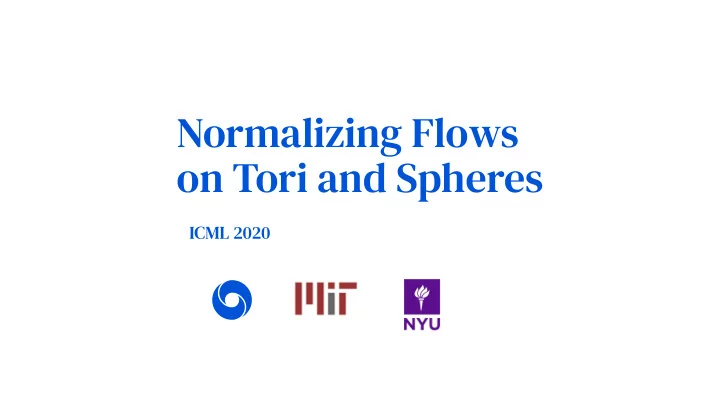

Normalizing Flows on Tori and Spheres ICML 2020
DeepMind Collaborators Danilo Rezende George Papamakarios Sébastien Racanière Center for Cosmology and Particle Physics, NYU Center for Theoretical Physics, MIT Gurtej Kanwar Phiala Shanahan Michael Albergo Kyle Cranmer
Overview ● Probability distributions on: Circles Tori Spheres ● As flexible as we like ● Any dimension we like ● With efficient and exact density evaluation and sampling
Why circles, tori and spheres? ● Not all data are Euclidean! Angles Joint configurations of Directions molecules / robot arms
Physics application: Estimating free energy System of particles with periodic boundary conditions Wirnsberger & Ballard et al., Targeted free energy estimation via learned mappings , arxiv.org/abs/2002.04913, 2020
Physics application: Simulating quantum fjelds on a lattice Kanwar et al., Equivariant flow-based sampling for lattice gauge theory , arxiv.org/abs/2003.06413, 2020
Directional statistics Common techniques: ● Wrapping (e.g. wrapped Gaussian) ● Projecting (e.g. projected Gaussian) ● Conditioning (e.g. von Mises-Fisher)
Normalizing fmows Sampling Density evaluation
Flows on the circle Fix endpoints: Positive derivative: Parameterize using angle: Match endpoint derivatives:
Flows on the circle: Three ways Möbius transforms Circular splines (CS) Non-compact projections (NCP) + rotation to fix endpoints
Expressive fmows on circle: Mixtures Composing Möbius (or NCP) transformations does not increase expressivity since they form a group. Instead, we propose an efficient method to create mixtures of them. Assume N flows on S 1 ● ● Define Still a valid diffeomorphism of S 1 with tractable Jacobian!
Flows on tori Autoregressive flow whose conditionals are circle flows (Möbius, CS or NCP)
Flows on tori: Results
Flows on the circle: Results Comparison of Möbius, CS & NCP
Flows on 2-spheres: Cylindrical coordinates Sphere to cylinder Cylinder to sphere
Flows on spheres: Recursive D-dimensional model
Flows on spheres: Results on S2 Target Flow samples Flow density
Flows on spheres: Results on SU(2) ⇔ S3 Target (top) vs flow (bottom) on a 3D sphere (shown are Mollweide projections)
Flows on spheres: Exponential-Map fmow
Autoregressive VS Exponential map fmows on N-Spheres Auto-reg Exp-map
Autoregressive VS Exponential map fmows on N-Spheres Method Autoregressive Exponential map ● Intrinsic to the sphere (does not require any particular coordinate system) ● Easy to scale ~O(N) Pros ● Defined everywhere on the ● Modular sphere (no numerical instabilities) ● Simpler to incorporate known symmetries ● Requires removing a set of measure-zero from the n-sphere, this may lead to numerical issues ● Requires a particular coordinate ● Hard to scale ~O(N^3) Cons system ● More constrained family of flows ● Hard to combine with domain knowledge about density (e.g. symmetries)
Takeaways ● Not all data are Euclidean! ● Directional statistics ● Normalizing flows on tori and spheres ○ As flexible as we like ○ Any-dimensional ○ Efficient and exact density evaluation and sampling ● Paper available at: arxiv.org/abs/2002.02428
Recommend
More recommend